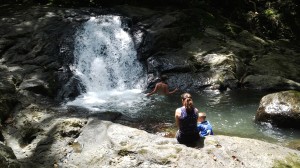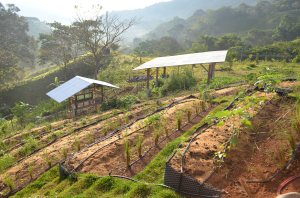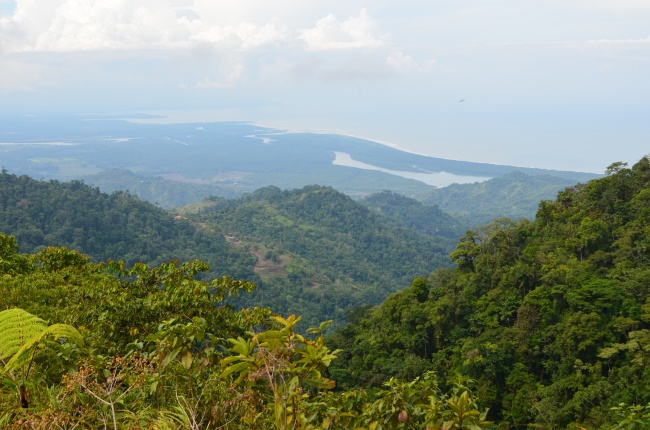Often when asked about my age, my response is met with disbelief. This happened again recently, when the inquiring person seemed convinced I was joking when I answered, “48”. A discussion ensued about many of the healthy changes we’ve embraced in our lives and…perfect blog entry!
One approach is to take you through a typical day at the Hinson homestead in the southern Pacific mountains of Costa Rica. Upon rising in the morning, the first priority is ‘oil pulling’ with organic coconut oil. What is oil pulling? It has been a staple of Indian ayurvedic medicine for thousands of years and has gained more and more followers in the west. Simply put about a teaspoon of coconut (or other) oil in your mouth and swish around for 10-15 minutes. Spit it out, then rinse twice with water and discard. It may sound crazy, but oil pulling can lead to countless improvements in your dental and overall health. Just make sure to use chemical free coconut oil so you “detox” instead of “retox”.
Next up is what we call the Water Chug. I drink about a liter (one quart) of room temperature water as quickly as possible…in about 30 seconds. Different folks have different capacities for the volume and timing, but the idea is to drink as much water as you can as quickly as you can. Why? Think of it as turning a hose to your GI tract, flushing everything that settled in your system overnight. It’s a great approach to detoxing and can produce incredible health benefits. Don’t confuse this with getting plenty of water during the day. The morning water chug is something entirely different.
After my coffee, the next unusual ingredient in our morning is a drink containing diatomaceous earth (DE). Made up in water or juice, DE powder is stirred in and quickly consumed. Why drink the fossilized “skeletal remains” of ancient algae? The outer shell of diatoms is largely composed of silica, along with a few other ingredients. DE is incredibly versatile, useful as an abrasive, for filtration, insect control, and pet and human health. For people, make sure to purchase food grade DE. The far reaching benefits for human consumption are beyond this blog entry, but please read up on this amazing natural product. We treat it as a general part of our detox routine, and we have good reason to believe it’s making a difference.
After all that…breakfast! There are far too many elements to our diet to summarize here, but suffice it to say we know the source of the vast majority of food and drink we consume. You are what you eat…let food by thy medicine and medicine be thy food…etc. We gave up beef, pork and poultry years ago, but we do enjoy fish and seafood a few times each month. The rest of our diet is heavy in locally grown rice and beans, along with a variety of eggs, fruits and veggies from our homestead. A common ingredient in much of Jill’s stellar cooking is organic coconut oil, something known to promote brain health. Results with coconut oil and dementia patients are often stunning. Turmeric and black pepper are also used liberally in the Hinson kitchen, for their many benefits when combined.

Quality, all natural personal care products comprise another point of focus for our family. High quality soaps from Red Mountain Goodness are extremely important to us, since commercial “soaps” are typically nothing more than a patented combination of detergents and chemicals. When you contemplate changes you can incorporate in your life that have the biggest impact, ponder what else do you spread over your entire body once a day. Now consider that your skin is a highly absorptive organ. Don’t believe me? Try rubbing a clove of garlic on your bare foot and count the seconds before the taste appears in your mouth! Shampoos should also be all natural whenever possible.
Deodorants that contain aluminum, polyethylene glycol, etc? If you consider the ever increasing breast cancer numbers in the “developed world” , you might want to avoid such ingredients. Baking soda is a very simple yet effective deodorant you can use. And the more “detoxed” your body becomes, the less need you’ll have for deodorant! Commercial toothpastes are another problem, and we’ve been working on our solution to that for the past year. As with anything that goes in or on your body, just make sure to read and understand the ingredient label.
Finally, our wood fired cedar hot tub is one of the last ingredients in our healthy routine each day. Not only does it help us to relax by lowering blood pressure, it’s another great way to remove undesirable toxins from your body. If we’re away from home for several days, I can literally feel the effects of not using our hot tub.

One final note…any of these changes in your healthful routine can initially produce side effects such as headache, upset stomach, general achiness, etc. If that happens, stick with the change for a few days and see if the symptoms subside. Often it’s due to the toxins buried deep in your body beginning to surface on their way out. During this transition period you may sometimes feel uncomfortable, but in the long run it is a short term price worth paying.
To your health!
June 2020 update….
Though this information remains completely relevant today, I do need to make a couple of additions. A newer part of our daily routine is grounding, or placing our bare feet in contact with the earth for 10 minutes. The reason is that doing so resets our energy to match that of Mother Earth, and the health benefits of that are amazing. See “The Earthing Movie” and “The Grounded” on YouTube for more information on grounding, and different ways to accomplish it. One excellent way is to simply ground your bed using a grounding sheet that you purchase or by using your own approach.
The other big addition to our health routine is taking bamboo charcoal powder. Though there isn’t a great deal of information about this supplement online, a similar commercial product is C60 Purple Power. You can read about that product to get an idea of the wide ranging benefits of taking charcoal powder daily. We mix our powder, made here at our homestead, with olive oil (1 part charcoal powder to 2 parts olive oil), then take 1 teaspoon of that daily. Typical results include increased energy, better concentration and multitasking, improved digestion, and many other reported benefits. My theory is that since the charcoal powder is almost pure carbon, and since we are carbon based, our bodies are able to use the excess carbon to optimize systems. That is why we hear that the powder tends to help with whatever health problem an individual has. But since charcoal can be detoxifying, heed my earlier advice about possible early aside effects. If you buy charcoal powder for daily consumption, make sure it is NOT activated. That is great for short term detox, but not for daily use.
Finally, including naturally fermented vegetables in your diet (not to be confused with pickled or canned!) adds powerful microbiotics that will improve your digestion, and quite possibly improve your mental health as well.
Let me know if you’d like more information about this amazing gift from God that you can make at home.
December 2020 update….
An important recent addition to our wellness routine couldn’t be much simpler. When drinking water throughout the day, we now add baking soda first….about 1/4 teaspoon per liter. This easy and inexpensive practice helps maintain an alkaline environment in our body, and this is key to protecting against most all diseases. Cancer and many other diseases require an acid environment to thrive. By maintaining alkaline conditions you stop them before they get started.
July 2023 update….
56 years old. 💪🏻💪🏻














